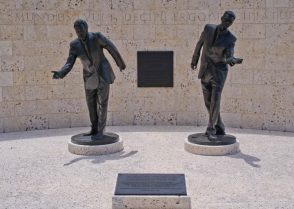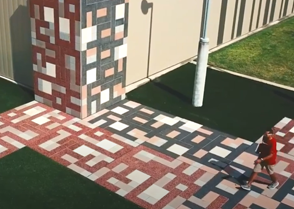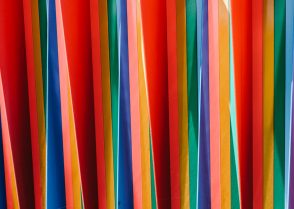Collection Videos
Explore our system-wide collection with quick videos that will make you feel like you are here in person.
The inscription along the stone backdrop for the Statue of Four Lies (2010) reads: Mundus vult decipi ergo decipatur (“the world wants to be deceived, so let it be deceived”).
The Palm Springs-based Jim Isermann created the architecturally integrated Untitled (Cougar Pride) (2014) for UH’s TDECU Stadium. This site-specific work was made to merge with the building rather than conceived as an object simply dropped into its location.
Inspired by the Nike of Samothrace, a 2nd-century BC Greek sculpture, Stephen De Staebler’s Winged Woman Walking X (1996) combines an interest in figuration and Classical mythology with post-War abstraction.
Frank Stella’s Euphonia (1997), a three-part mural at UH’s Moores Opera Center, is an act of sheer generosity. The artist specifically created it to be shared—communally and in a setting alive with music and gatherings.
George Smith’s lifelong pursuit revolved around merging mainstream Minimalism and the abstract symbolism of West African cultures. Smith remained steadfast in this commitment even as many of his contemporaries moved towards greater nonreferentiality.
Alyson Shotz is known for work that may seem preoccupied with materiality, but in fact is more concerned with examining how materials change as a result of variations in light and darkness.
Climbing upward in front of the Houston skyline, visible through the plate-glass wall of UHD’s Shea Street Building, Jacob Hashimoto’s Cloud Deck (2010) is an artwork that appears to be in motion, radically transforming as the viewer moves up or down the staircase.
The son of a commercial sign maker in El Paso, Luis Jiménez was inspired by a wide range of cultures, but his Mexican-American heritage was prominent throughout his work. The monumental Fiesta Jarabe (Fiesta Dancers) (1991-93) epitomizes this interest along with a parallel concern with folding in commercial techniques and materials such as fiberglass.
Gael Stack explores language, memory, and the limits and curious natures of both. By using a deep color as a ground, such as the cobalt blue in Untitled (2008), she references infinite space or possibly blueprints of things.
A pivotal figure in the early Houston art scene, James Surls is known for sculptures that blend the language of modernism and folk art. He grew up on a farm in East Texas, where he learned to work with natural materials, like his favorite medium, wood, and use many of the tools he has folded into his art production over the years.
Carlos Cruz-Diez created art for ordinary people and saw color as a fundamental part of our everyday experience, as a means to connect with others. Early on he made a living as an ad man in his native Caracas but, in 1955 while working in graphic design, he realized that certain color combinations resulted in virtual colors that did not actually exist on the page.
Pablo Serrano’s Spiritus Mundi (1977) takes its name from the Latin concept for humanity’s spiritual source, which W. B. Yeats famously invoked in The Second Coming of 1919.
For sculptor Kendall Buster, there is no distinction between art and science. Trained as a microbiologist, she initially explored the forms she saw through a microscope. Indeed her large-scale sculptures such as Flow recall early experiences in the lab.
Prayer Meeting (1997) by the late artist and activist John T. Scott, was inspired by the broad African American experience of the South. The unique fusion of African, Caribbean and Creole cultures in New Orleans, where Scott was born, provided a fecund framework for his work.













